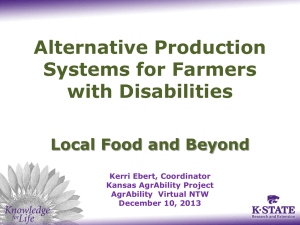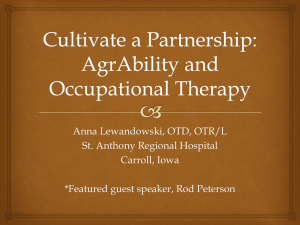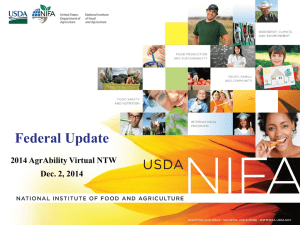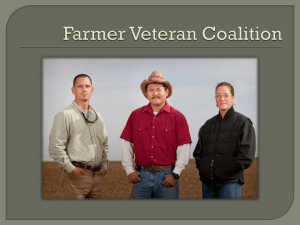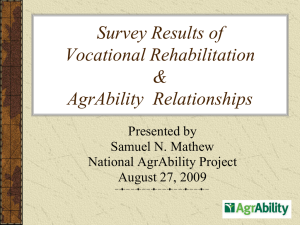Examples – Niche Markets - National AgrAbility Project
advertisement
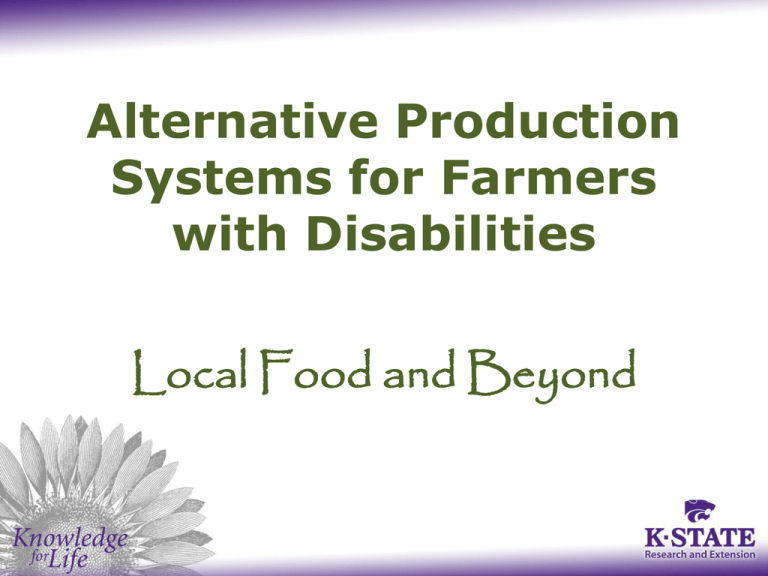
Alternative Production Systems for Farmers with Disabilities Local Food and Beyond Learning Objectives 1. Learn about small scale and alternative ag production methods 2. See examples of small scale and alternative production methods used in Kansas 3. Discuss possibilities for your states and identify resources Why this topic at this time? • United States Department of Agriculture Economic Research Service (USDA ERS) Report – January 2013 – Food Insecurity Among Households With Working-Age Adults With Disabilities • There is a strong association between disability and food insecurity • 33.5% of households with an adult who is not in the workforce because of disability are food insecure Why this topic at this time? • Veterans – Gulf Wars I and II have resulted in 1.6 million veterans who fought for America and survived. – Approximately 10% of post-9/11 veterans are officially classified as disabled. – About 45% of veterans are seeking disability benefits from the Veterans Affairs (VA) Department. – 3.5 million = total number of veterans with a serviceconnected disability – The unemployment rate for Gulf War I and II veterans hovers around 9%; some sources put it closer to 20% Total population of veterans is >21.5 million; 1.6 million of whom are female. Source: U.S. Department of Veterans Affairs We Need More Farmers! • Local Food Movement – Consumer driven – Opens new market opportunities for farmers – Increases demand for new farmers • Self Employment can be an excellent opportunity for people with disabilities In Kansas we don’t have enough produce to meet the consumer demand at our largest farmer’s markets. Small Scale Ag & Alternative Crops • The Worldwatch Institute*: A move from industrial farming towards local food projects is our healthiest, most sustainable choice. • Food waste – another reason for more local growers – – – – Prepared and not eaten Damaged in transport Spoilage Unsold fresh produce in stores *State of the World Report 2011: Innovations that Nourish the Planet We Need More Growers! • Can we (AgrAbility) help bridge the gaps between: – Americans with disabilities and food security – AgrAbility customers and increased local food supply ? YES, WE CAN In fact, we’ve already started. So let’s look at some types of alternative food production and niche markets that can and do work for people with disabilities. Because small-scale farming is an excellent self employment option! Small Scale/Alternative Options • Traditional Fruits – Tree fruits (apples, peaches, pears, cherries) – Bramble fruits (blackberries, raspberries) – Small fruits (blueberries, strawberries) • Specialty Fruits – – – – Figs (growing zones 6-9) Elderberries (growing zones 4-8) Currents (growing zones 3-7) Kiwi (growing zones 5-8) • Herbs – culinary and medicinal Small Scale/Alternative Options • Traditional Vegetables – Tomatoes – Peppers – Squash • Specialty Vegetables – Miniature and/or colored anything • Yellow or purple carrots; 8-ball zucchini; yellow beets – Ethnic vegetables – varies by location and local ethnic population • Bok Choy and other Choys • Chinese cabbage Source: USDA, Alternative Crops & Enterprises for Small Farm Diversification Small Scale/Alternative Options • Animals (protein) – Game-related – buffalo, deer, fish bait, pheasant, quail – Minor Breeds – goats, sheep, rabbits – Poultry – chickens, ducks, pigeons – Aquaculture – tilapia, shrimp Conventional OR Organic? It’s up to the producer and the consumer Source: USDA, Alternative Crops & Enterprises for Small Farm Diversification Examples – Niche Markets Source: Kansas AgrAbility Project Examples – Niche Markets Source: Kansas AgrAbility Project Examples – Niche Markets Source: Kansas AgrAbility Project Examples Source: Kansas AgrAbility Project Examples Source: Kansas AgrAbility Project Examples Source: Kansas AgrAbility Project Examples Source: Kansas AgrAbility Project Examples Source: Kansas AgrAbility Project Examples Source: Kansas AgrAbility Project Examples Source: Kansas AgrAbility Project Examples http://www.youtube.com/watch?v=R1mL8G0iRWc&feature=youtu.be Source: Kansas AgrAbility Project Resources United States Department of Agriculture (USDA) – www.usda.gov – Alternative Farming Systems Information Center, http://afsic.nal.usda.gov – National Agricultural Library • Alternative Crops & Enterprises for Small Farm Diversification, http://www.nal.usda.gov/afsic/pubs/altlist.shtml – Start2Farm, http://start2farm.gov/ – Farm Service Agency, http://www.fsa.usda.gov Resources For Veterans – Information for Veterans • http://www.outreach.usda.gov/veterans.htm – Farmer Veteran Coalition, http://www.farmvetco.org/ • Veteran Careers in Agriculture: A Resource Guide, AgrAbility featured on Page 31 – Combat Boots to Cowboy Boots, http://ncta.unl.edu/ • Nebraska College of Technical Agriculture, Curtis, NE – 100 Beef Cow Advantage Program – 100 Acre Farm Advantage Program Resources • ATTRA – National Sustainable Agriculture Information Center – https://attra.ncat.org/ • Sustainable Agriculture Research and Education (SARE) – http://www.sare.org/ • eXtension (virtual Extension office) – http://www.extension.org/ Local Resources • USDA County Offices – Farm Service Agency (FSA) – Rural Development (RD) – Natural Resources Conservation Service (NRCS) • County/Area Extension Offices – Master Gardener Programs – Community Garden Program – Farmers Market Information Local Resources • State Department of Agriculture • State SARE Coordinator • State Commission/Department of Veterans Affairs • Small Business Development Centers • State Farm Organizations – Farmers Union – Small / Sustainable Farmers Associations Kerri Ebert Kansas AgrAbility Project kebert@k-state.edu http://agrability.bae.ksu.edu
